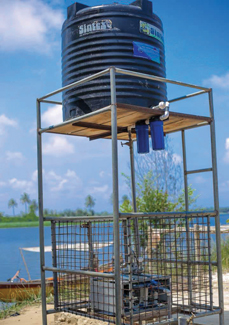Dialyzers get second life to bring clean water to developing countries
Dialysis is a resource-intensive process with a big environmental footprint. It relies heavily on disposable products, including needles, blood tubing, dialyzers and large amounts of electricity and clean water.
A new company formed by several dialysis veterans is taking one of the largest disposable items — dialyzers — and repurposing these to create a simple water purification system for developing countries that does not require electricity.
The non-profit organization, called Easy Water for Everyone, has made inroads in two African regions where water sources in villages are often contaminated with high levels of fecal E. coli bacteria.
“Many of the western world’s clinical experts and the media have noted staggering and alarming degrees of morbidity and mortality in the young (age 5 years or younger) due to severe contamination of drinking water in rural areas of third-world countries,” according to the company’s website. “Significant data are available now indicating that diarrheal disease is a major cause of morbidity and mortality among children in Ghana and in many other developing countries.”

Source: Linda Donald
The company board of directors includes Linda L Donald, MA; Seth Johnson, RN, MSN, FNP, CNN; Jochen G Raimann, MD, PhD; Nathan W Levin, MD, FACP; Ben Lipps, PhD; Fritz Port, MD; and Daniel N.O. Sackey.
The purification device, called the NUF500, is made of eight sanitized dialyzers and takes about 4 hours to set up. The hemodialyzers are replaced every 2 years at $8 per hemodialyzer. An eight-dialyzer device can produce pure water at a rate of 500 L per hour with manual pumping and at 250 L per hour with a gravitational system. The pore size of the dialyzer membrane is 0.003 µm, which does not permit passage of viruses, bacteria and parasites. Regular backwashing is needed, depending on the degree of sediment in the water, and protection from sunlight is achieved by using dark tubing in the device to prevent algal growth.
The company has focused on two African countries, Ghana and Uganda, because of their large rural populations and a widespread lack of drinkable water and electrical power. As of March 2019, 16 village sites have been equipped with the NUF500.
Data were presented at the World Congress of Nephrology in April detailing the process of the program.
“Because of its efficiency and considerably low cost, the device is suitable for use in rural communities with limited infrastructure. The efficacy of the technology to remove pathogens from contaminated water is expected to substantially reduce the incidence of diarrhea, AKI and of mortality, particularly in children less than 5 years of age,” according to the abstracts.
Data from 3,611 villagers for 17 months from the 12 studied communities in Ghana showed a declining trend in the overall incidence rate of diarrhea following the implementation of the filtering device in the village structure and was reduced from 1.5 to 0.8 cases per 1,000 person days from the before to the after period.
“While our data requires a larger sample size and further statistical analyses accounting for village characteristics, seasonality and subject demographics, the obvious decline in incidence rates supports widespread use of membrane filtration devices, particularly in rural regions,” according to the abstract.
More information on Easy Water for Everyone and the NUF500 is available at www.easywaterforeveryone.org.
Editor’s note: On July 30, 2019, the editors updated the pore size of the dialyzer membrane. It is 0.003 µm, not 0.003 Mm as previously published. The editors regret the error.
References:
- Levin, N et al. Use of a hollow fiber dialyzer-based device to provide pure water in villages. Presented at: the World Congress of Nephrology; April 12-15, 2019; Melbourne, Australia.
- Raimann, JG. Decentralized water purification using membrane filtration reduces the incidence of diarrhea in communities in developing countries. Presented at: the World Congress of Nephrology; April 12-15, 2019; Melbourne, Australia.
- www.uptodate.com/contents/maintaining-water-quality-for-hemodialysis
